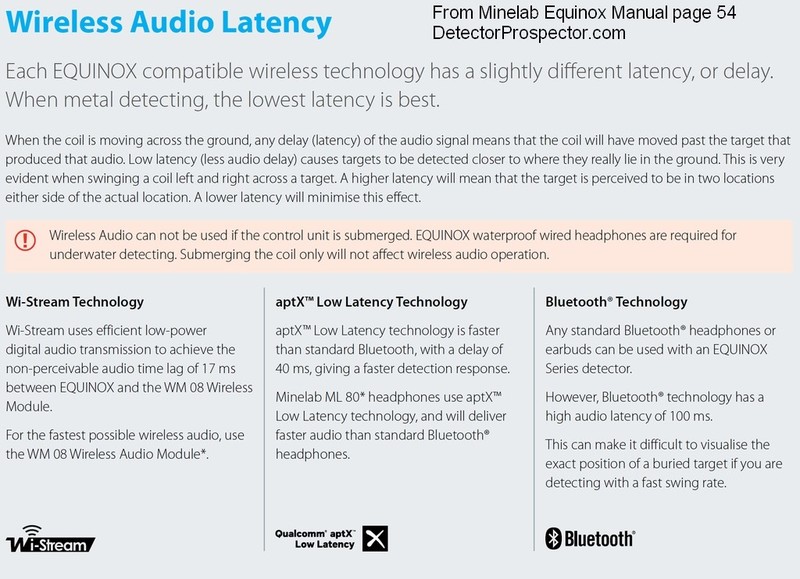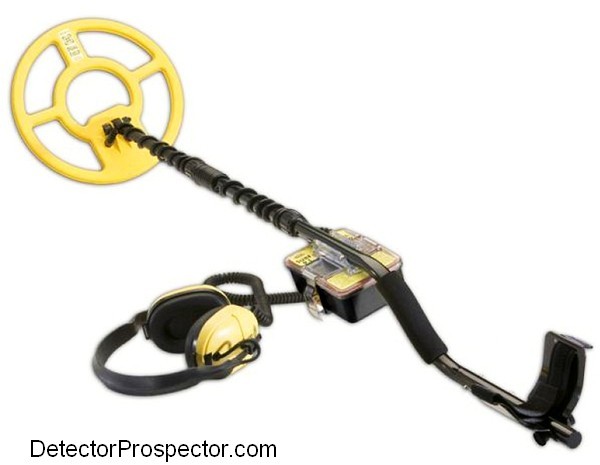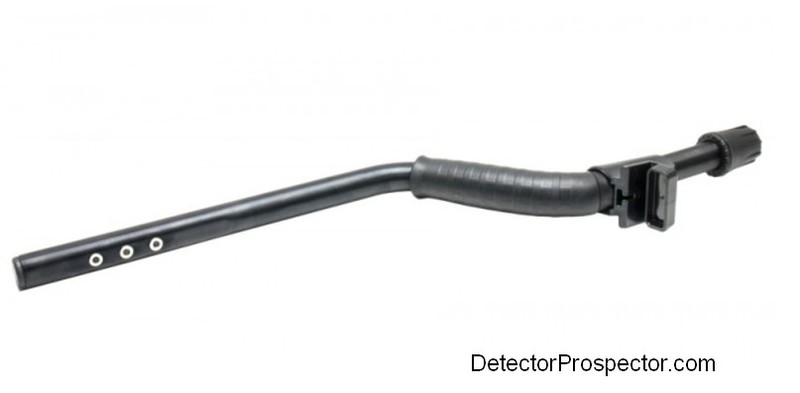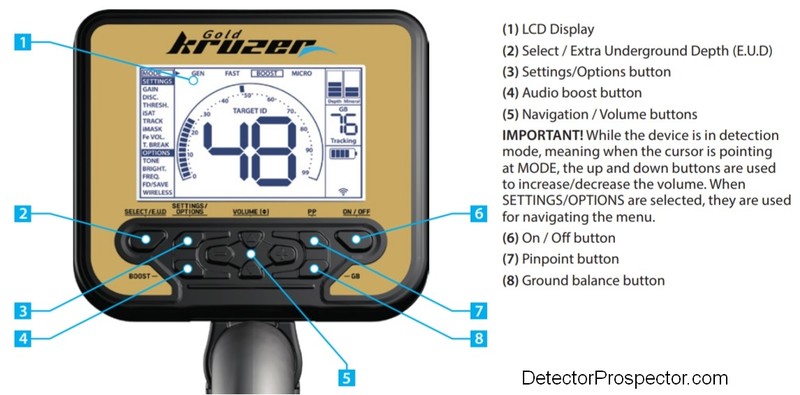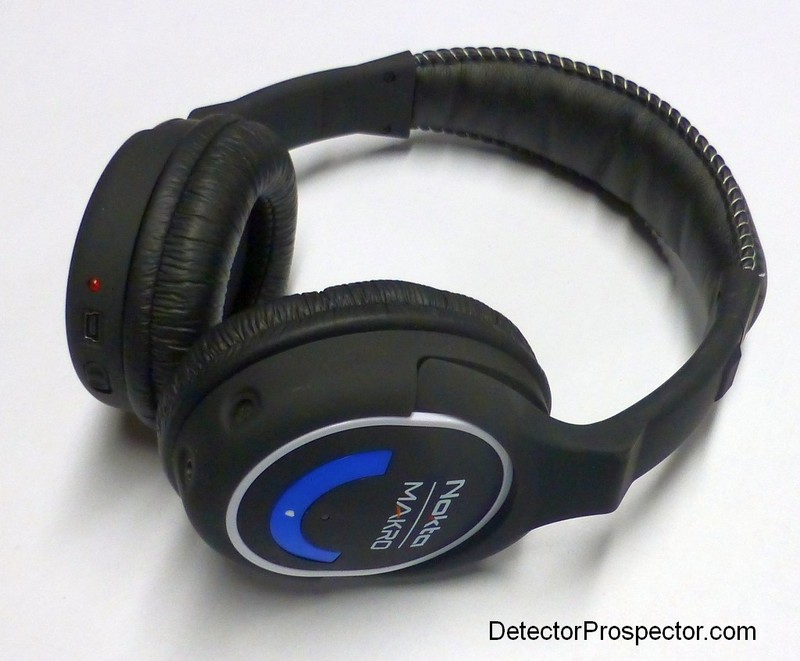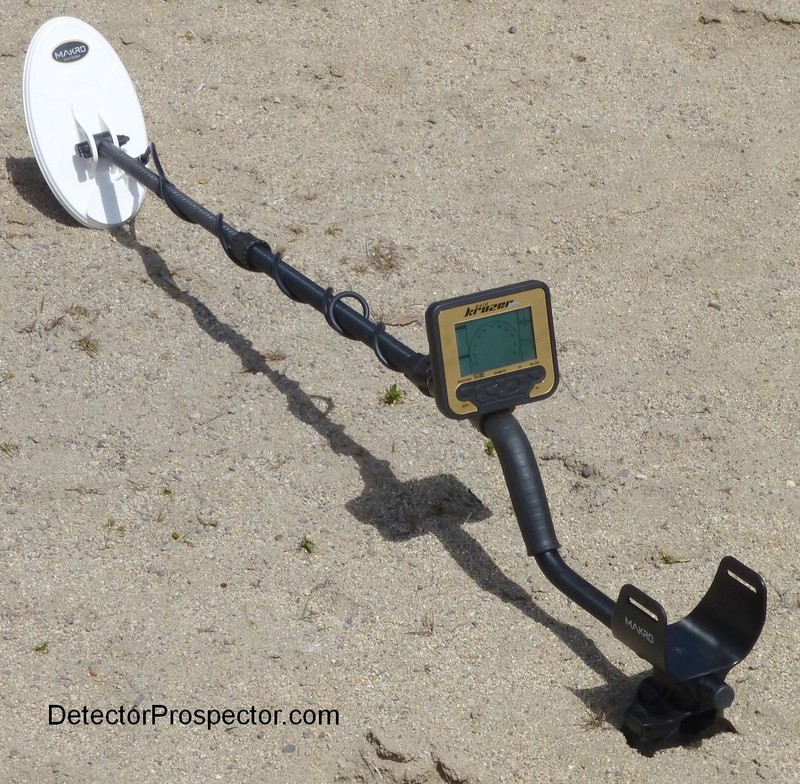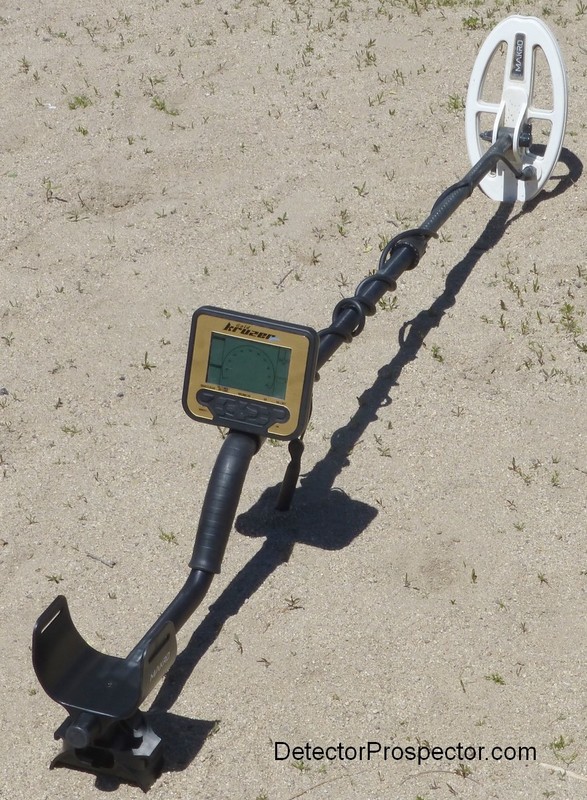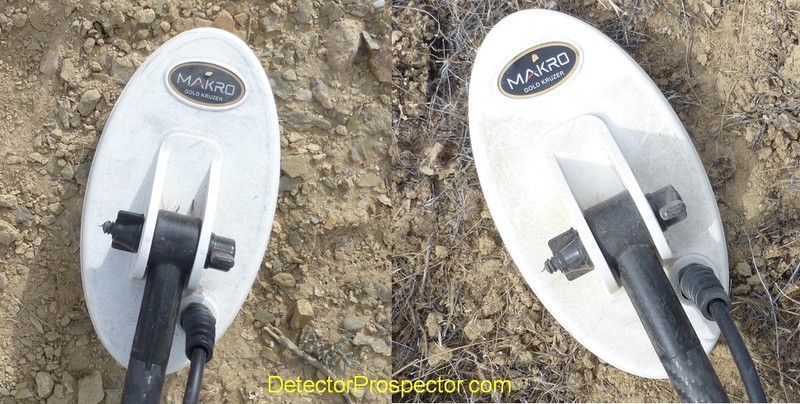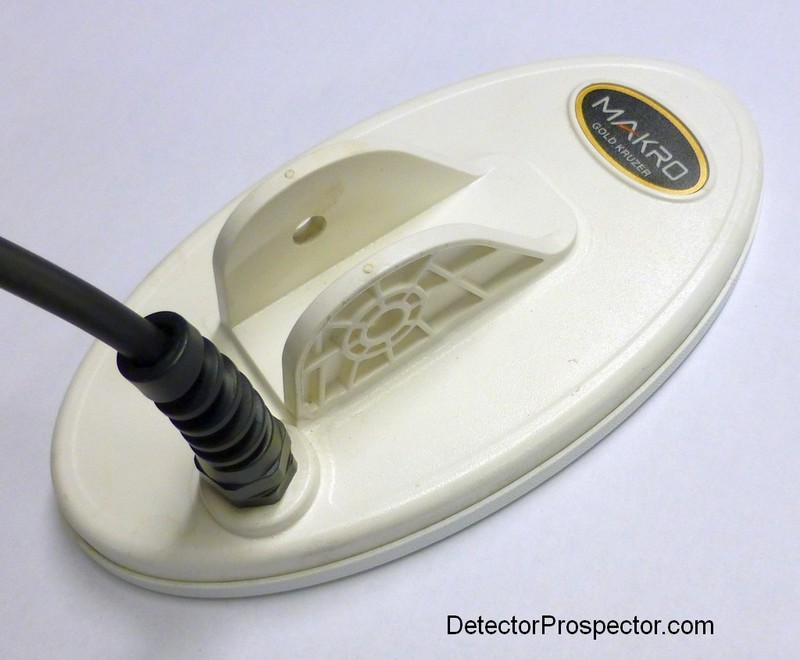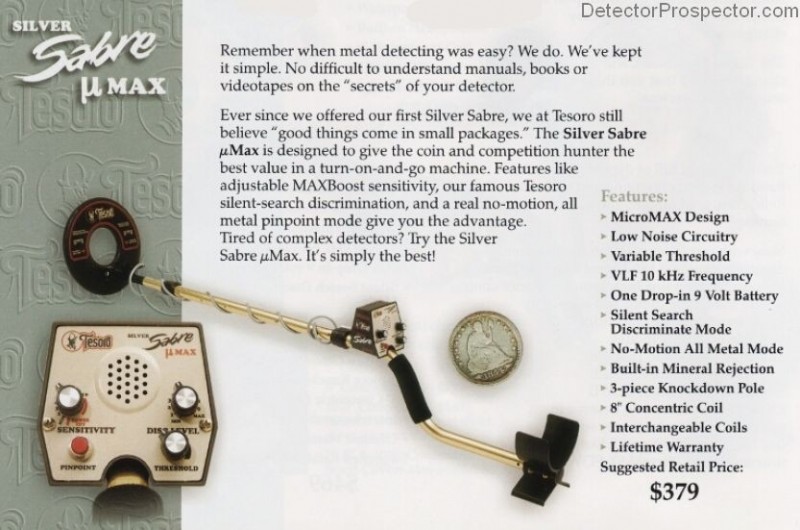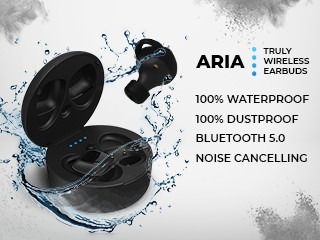-
Posts
19,822 -
Joined
Content Type
Forums
Detector Prospector Home
Detector Database
Downloads
Everything posted by Steve Herschbach
-
You could use two together to totally bypass the Equinox wireless system. Or you can use one in receiver mode as a receiver box for the built in Equinox aptX low latency Bluetooth. What it can't do is replace the WM 08 in full, since the WM 08 is a receiver box for the even faster Minelab proprietary system. Standard Bluetooth - up to 100 ms aptx Bluetooth - up to 40 ms Wi-Stream (WM 08) - up to 17 ms
-

Platinum At Last!!!!!!!!!
Steve Herschbach replied to Rivers rat's topic in Metal Detecting For Jewelry
Very nice - congratulations! Platinum is a special find for sure, and a Cartier at that. -

MX Sport Comes Now With Waterproof Headphones
Steve Herschbach replied to Ridge Runner's topic in White's Metal Detectors
Actually all underwater detectors came with waterproof headphones until recently because they were all hardwired to the detector! Like with White's Surf PI. It's only in recent years that waterproof connectors have become commonplace and reliable enough that we now have removable headphone options. -
The following is a very detailed review of the new Makro Gold Kruzer... but first a little back story. I was asked to review a new gold detector in the fall of 2014 from a company I had never heard of before then – the FORS Gold by the Nokta company based in Istanbul, Turkey. I was pleasantly surprised to find the Nokta FORS Gold to be a very capable 15 kHz VLF detector that could serve well not just for nugget detecting, but almost any detecting tasks. The FORS Gold did have some odd design quirks, like the use of mechanical rocker switches instead of touch pads. I listed a few of these things, expecting that would just be the way it is. I was almost shocked when within a short period of time Nokta fixed or changed every item I had mentioned in my review as possibly needing improvement. This was unusual as normally once a machine has gone into production manufacturers are extremely resistant to design changes, especially changes in the physical design. It was a sign of what people have now found to be fact – that this company is serious about listening to their customers as a prime driver for product improvement. New Makro Gold Kruzer It was revealed that Nokta had a sister company called Makro, and the two officially combined forces shortly after I made my review. In other words, both Nokta and Makro now share the same ownership and management, but continue to be marketed separately under the two brand names. The detector models that each sell are unique, but there is an obvious sharing of the underlying technology between some models that the two brands sell. I had commented at the time that I would prefer a more standard configuration for a LCD based detector rather than the non-standard configuration as presented by the FORS Gold. By the fall of 2015 I was using the new Makro Gold Racer, which incorporated many ideas I had lobbied for over the years with detector manufacturers. I had been trying for some time to get somebody to create a metal detector that ran at nugget detecting type frequencies over 30 kHz but with a full target id system. It seems strange now but at that time nobody made such a detector. The Makro Gold Racer was quite unique in 2015 by offering a detector running at 56 kHz that also offered a full range LCD based target id system and dual tone based audio discrimination modes. This made it a detector useful not just for nugget detecting, but low conductor hunting in general for relics and jewelry. It is even a halfway decent coin detector for regular park type scenarios. The versatility and well thought out control scheme scored points with me, and I still have the Makro Gold Racer even after selling most of my other detectors. It seems that the moment the Makro Gold Racer hit the streets, that everyone else was working on similar ideas, as other detectors running over 30 kHz but with a full feature set started to appear on the market. High frequency detecting is suddenly in vogue for more than just gold nugget detecting. The one thing obvious now about the Makro / Nokta partnership is that they never sit still, but continue to work on and release new models at a pace that puts all the other manufacturers to shame. The companies are also big believers in seeking public feedback and then implementing the suggestions to create better products for their customers. This is readily apparent in the progression I have personally witnessed in going from that original Nokta FORS Gold to the new 61 kHz Makro Gold Kruzer just now hitting the market. In less than four years the company has gone from “catching up” to meeting or surpassing detectors made by other companies. The Makro Gold Kruzer has a full suite of functions, is fully waterproof, incorporates built in wireless headphone capability, and can be firmware updated over the internet. That short feature list alone puts the Makro Gold Racer in a very select group of detectors offering those same 21st century “basic features” that were lacking in almost all detectors made in the last century. The Makro Gold Kruzer obviously builds on the Gold Racer feature set with the following key differences. The Gold Racer runs at 56 kHz and the Gold Kruzer at 61 kHz, one of the highest frequencies available in consumer metal detectors. This continues the focus on detecting small low conductor targets. The Gold Kruzer is waterproof to 5 meters (16.4 feet) whereas the Gold Racer is not waterproof at all. Finally, the Gold Kruzer adds a three tone hunt mode, taking things up another step from the dual tone modes available on the Gold Racer. Now let’s look at the Makro Gold Kruzer in detail. Makro switched things up in that the Gold Kruzer comes with two coils, a 5.5” x 10” concentric coil, and a 4” x 7.5” DD coil; both include scuff covers. The 5.5” x 10” concentric coil, which was an option offered for the Gold Racer, has been redesigned and cut from 1” thick to ¾” thick and the weight reduced to 384 grams (13.5 oz). The coil is hollow and therefore slightly buoyant, so the 25% reduction in thickness is quite welcome in reducing that buoyancy to where it is basically unnoticeable underwater. The little 4” x 7.5” DD coil is a solid epoxy filled coil which works extremely well in smaller coils where epoxy filling does not result in too much weight. The small DD coil weighs 368 grams or 13.0 oz. There is one accessory coil available at this time, a 5” x 9.5” epoxy filled DD. This coil weighs 14.3 oz or 404 grams. It should be noted that because of the frequency change and with the Gold Kruzer using waterproof connectors, that Makro Gold Racer coils will not work on the Gold Kruzer. Makro has also learned lessons as regards coil ear durability. The coil ears on the Gold Kruzer are about twice the mass of those on my older Makro Gold Racer. Taller, wider, and thicker – these extra beefy coil ears should all but eliminate breakage issues. 4” x 7.5” DD coil showing beefed up ears The Makro Gold Kruzer employs a fairly standard “detector pod on an S rod” design forgoing the underarm battery box used on the Gold Racer. This confers a large advantage when it comes to waterproofing the detector in that only the pod has to be sealed. The change from AA batteries to a built in sealed LiPO rechargeable battery also aids in eliminating battery doors, which are always at risk of leaking. The three piece S rod itself is quite stout with no flex or wiggle. The cross hatch carbon fiber lower rod is not only strong, but lends an air of high tech quality to the look of the detector. The Gold Kruzer does not have the separate underarm battery compartment and in handle vibration mechanism featured on the Makro Gold Racer. This means the pod is totally self contained and can be removed from the handle assembly. This in turn allows for other rod options and the ability to break the detector completely down fitting in a small backpack or carry on bag. When the stout rod is combined with the beefed up coil construction you have a design that should survive those spills a person can take when working in the surf and there the detector ends up acting like a walking stick for support. It has been interesting to watch the company experiment with different handle designs. It is a thankless task because you never can please everyone. For me at least the handle / rod may be the best yet from Makro, with a molded hard rubber grip that will serve very well for a detector that may see underwater use. I personally found the Nokta Impact handle to be large for my hands and the smaller Gold Kruzer handle near perfect. Others may feel just the opposite so there you go. The arm cuff is a little different. It is narrower than some – good for me but maybe not so much for somebody with huge forearms. The adjustment is non-standard, with the arm cup sliding up and down the upper rod over a set of threaded holes. A small screw inserted into the top of the armrest and into one of these threaded holes secures the armrest in place. Kruzer upper rod showing cuff adjust holes and hand grip (control box removed) A unique feature on the Gold Kruzer is an optional external AA battery pack that can provide extra operating time in the field should the internal rechargeable battery go dead. The pack is designed to be held into the bottom of the detector armrest / stand by a separate plastic cover bracket that is held in place with two screws. I found the holes these screws go into will fill with sand if this bracket is left off, so I advise installing the bracket even if the external battery pack is not in use. The external battery pack with bracket is an option and so dummy screws or plugs should be installed to keep the screw holes clean and free of debris by those who down not have the bracket. I don’t think most people will ever need the external battery pack as long as the detector is regularly charged after use. It is a very nice touch however, especially for off grid use, as all you need is the external AA battery pack and a box of AA batteries to off grid for as long as the batteries will last. Some people may want the optional battery pack for travel into the field just in case the battery runs short on power in the middle of a hunt. The port where you attach the external battery pack also acts as a port to attach a USB style charger cable. The detector is charged using this cable by employing the included USB wall charger. You may also use most USB charging adapters and newer computer USB ports. The USB cable also allows the Makro Gold Kruzer to be attached to a computer so that updates can be made in case any bugs are found in the future. This update feature is very nice insurance that should be standard on all new detectors. Another item that should be standard on all new detectors is built in wireless headphone capability. Makro uses a proprietary low latency system that exhibits no discernible lag at all. A really nice thing about being proprietary is there is no pairing process. All you have to do is enable the wireless feature on the control box, turn on the headphones, and boom, you are in business. The downside is you only have one choice of headphones – the included Makro wireless headphones. These are a nice, light set of phones but they are just a bit too small to fit over most people ears. I have fairly small ears and they still rest on instead of over my ear. The sound quality is good, but like most wireless headphones they seem less “bright” than wired headphones. All in all the wireless headphones are quite good however and a pleasure to use. Makro wireless headphones The Makro Gold Kruzer does have a waterproof speaker with decent volume that can be used instead of the wireless headphones. If you prefer other headphone options, be sure and get the optional waterproof port to ¼” headphone adapter cable. This cable attaches to the same port used for charging and software updates and allows any wired headphones to be adapted to the Gold Kruzer. The LCD display is well laid out with a very large target id number displayed. The other setting indicators might be a little harder for those with poor eyesight to make out, but should present no issues once the layout is learned. One big change from the Gold Racer is that the four large navigation buttons, trigger switch, and rotary dial power / volume switch have all been replaced by ten small buttons on the control panel. All the buttons can be reached and controlled by the operators thumb, but the small size and closeness of the buttons may make for some navigation errors early on, and especially when trying to change settings underwater or with gloves on. Makro Gold Kruzer display and controls The Makro Gold Kruzer User Manual is available for download so I will refer you there for all the little details. What you have in the Makro Gold Kruzer is a hot 61 kHz metal detector waterproof to 5 meters (16.4 feet). The Gen (General) mode is a fairly standard VCO audio all metal gold nugget detecting circuit. The Gold Kruzer in Gen mode is very reminiscent of other hot gold nugget detectors running in the all metal prospecting mode. The Gen mode acts exactly like one would expect a threshold based all metal mode to function. There is a nice smooth threshold that gives feedback about the ground and reacts to hot rocks with classic nulling signals and small nuggets with that classic “zip-zip” VCO audio. Voltage Controlled Oscillator (VCO) audio increases both in volume and pitch when a target is detected, giving a distinct response very common on many gold detectors. The only thing different here is that since the Gold Kruzer has an LCD readout; you can get target id number results while running in all metal Gen mode. The audio is far more sensitive than the meter however, so do not be surprised if the deepest and smallest of targets give no target id information. In a break with the Gold Racer the Fast and Boost modes are not dual tone modes, but instead are silent search (no threshold) single tone modes. Items either signal audibly or not based on the current discrimination settings. The discrimination setting, like that of the Gold Racer, is a simple up and down control. Everything above the setting gives an audio signal of “beep”. Anything below the discrimination setting level is rejected or ignored with no sound at all. The Gold Kruzer has no notching capability i.e. the ability to pick and choose individual target id numbers for rejection. Fast mode is just what it sounds like – a fast setting for working in really dense trash. Target recovery speed has been increased at the expense of outright depth, but sheer depth is useless where target masking is the main problem. Boost mode is exactly the opposite. Boost is the deepest discrimination mode on the Gold Kruzer but due to the increased sensitivity is more suitable for less mineralized ground and sparser targets. It should be obvious that the Makro Gold Kruzer is all about gold. This explains the shift from dual tone to monotone audio in the Fast and Boost. Dual tones as employed in the Makro Gold Kruzer can be problematic when hunting the smallest gold targets, especially in highly mineralized ground. It is hard for a detector to get a clean separation of ferrous and non-ferrous targets when the targets are very small. This is because the actual dividing line between ferrous and non-ferrous is not a line at all, but a zone. The Makro Gold Kruzer uses a fairly standard discrimination scale that ranges from 0 – 99. The range from 0 – 40 is considered to be the ferrous range, and 41 and above non-ferrous. Yet the discrimination default for both the Fast and Boost modes is 25. This is because if you bury small gold in highly mineralized ground or large gold extra deep in mineralized ground, the ferrous ground signal can overwhelm the very weak non-ferrous signal. It really is not about the object size. A deep large nugget is a very weak signal just the same as a shallower small nugget, and either can end up reading as a ferrous target. The solution is to lower the discrimination setting into the ferrous range and accept that you have to dig some ferrous items to get all the gold items. This actually applies to any metal detecting. If you dig absolutely no ferrous trash, you are almost 100% guaranteed to be passing up some non-ferrous items reading incorrectly as ferrous. This can be acceptable of course depending on what you are doing, but passing on a deep six ounce gold nugget because it reads ferrous can be an expensive mistake. The Gold Kruzer default discrimination setting for Fast and Boost is 25 instead of 40 for this very reason. Dual tones have issues for this same reason, with decisive results on the weakest targets difficult if not impossible to obtain. The difference is quite small, but monotone is slightly more stable and proficient at working with the tiniest and faintest of signals right at the dividing line between ferrous and non-ferrous, wherever you have set the control to tell the Gold Kruzer where that line is for your particular situation. There is no pat answer as the where to set the discrimination control. It is a judgment call based on experience, but when in doubt, use less discrimination and dig more trash. Welcome to gold detecting! Makro chart showing gold occurring in 0 – 40 ferrous range The Makro Gold Kruzer has a new control that relates to this overlap between ferrous and non-ferrous readings. The Extra Underground Depth (E.U.D.) control acts to directly impact the tipping point between ferrous and non-ferrous readings. The E.U.D. control only works in one of the three discrimination modes and when used on a suspect target that is reading ferrous may reveal by a different tone that it is actually non-ferrous. It is noted in the manual that it can reveal some targets misidentified as ferrous, but it will also give more false positives on ferrous targets. I was unable in the time allowed to figure out just how efficient this control is. In theory you can just set the discrimination lower, digging more ferrous but getting those missed non-ferrous items. Or set the discrimination a little higher, and now examine suspect targets individually by engaging the E.U.D. control momentarily. Finally, you can run E.U.D. on at all times. Is higher disc with E.U.D. on at all times going to get better results than just using a lower discrimination setting? Sadly, I just do not know at this time. I do know it is no magic bullet so the efficiency of employing the E.U.D. control will have to be determined over time by users around the world What? You say you wanted tones? Well, the Makro Gold Kruzer has you covered. The new Micro mode is a three tone mode similar to that on other company models, but running at that hot 61 khz. The 0 – 40 target id range produces a low tone. The 41 – 66 range produces a medium tone, and 67 – 99 range a high tone. Micro mode allows the “ferrous break point” to be adjusted. This is that magic point where you decide what is going to read as ferrous and what reads as non-ferrous. Note that unlike the Fast and Boost modes, the default ferrous breakpoint is set at 40 instead of 25. This is good for coin type detecting but again may be too high for other types of detecting. While in Micro mode you may use the Tone Break control to vary this all important setting. You could mimic the other two modes by setting the Tone Break at 25. Now 0 – 25 will be a low tone, 26 – 66 a medium tone, and 67 – 99 a high tone. Tone Break can only be used to set the ferrous breakpoint. The upper high tone region of 67 – 99 is preset and fixed by the factory with no adjustment possible. You may use the Ferrous Volume setting to control how loud the low tone response is. The medium and high tone responses are set with the main volume control. The discrimination control still functions in Micro mode, with a default setting of ten. Hot rocks and ground responses occur this low on the scale, and so having at least some of the low end blocked or rejected with reduce the number of low tone responses generated by the ground itself. The control can be set as high as you want and will override the other settings, blocking all targets below the desired target id setting. The Makro Gold Kruzer does have a tone control, but it does not allow the tones to be changed in Micro mode. Those are factory preset, with the Tone Break between ferrous and non-ferrous plus Ferrous Volume as the two adjustments you can make. The Tone setting allows the tone of the audio response and threshold to be changed in Gen, Fast, and Boost modes only. Micro was designed first for hunting micro jewelry. Micro jewelry is a loose term that applies to all very small jewelry items, like very thin chains, single post earrings, tie tacks, etc. Micro is perfect for hunting tot lots and beaches and focusing on the “gold range” targets represented by the mid tone reading in Micro mode. Many jewelry hunters consider digging coins a waste of time, and so ignoring high tones can save digging pocket change when the real goal is a woman’s diamond and platinum ring. The Makro Gold Kruzer has a nominal non-ferrous range of 41 – 99 which is a 59 point spread. Normal U.S. coin responses are 63 for a nickel, 83 for a zinc penny, 84 for a copper penny, 86 for a clad dime, and 91 for a clad quarter. The high 61 kHz operating frequency acts to push target id numbers higher and most coins will respond at 83 and higher. I was surprised a zinc penny and copper penny for all intents read the same. The good news is the low conductor range is expanded, which offers the ability to help discern different pull tabs and other trash items over a wider range. This in turn may help eliminate at least a few pesky trash items while hunting gold, although ignoring gold range items of any sort can be risky. Still, with a U.S. nickel reading at 63 and most women’s rings reading under the nickel, you get the 40 – 63 zone as a 23 point range where much of the most valuable jewelry will turn up. The default high tone breakpoint of 66 – 67 is clearly focusing the Gold Kruzer mid-tone on this very important gold range. Do note that large men’s rings and nearly all larger silver jewelry will read above 66 and therefore give a high tone reading. The Gold Kruzer has some obvious applications but there are a couple catches. First, it is running at 61 kHz, which means it is very hot on low conductors, but that it will have just adequate performance on high conductors like silver coins. Second, its extreme sensitivity to low conductors means it will not work well if at all in saltwater or on wet salt sand. Saltwater is a low conductor and will respond quite strongly on the Gold Kruzer, and getting it to not respond to saltwater gives up all the sensitivity to small gold. The Gold Kruzer will work very well around freshwater or on dry sand, it is not intended as a detector for use in or near saltwater. I would suggest the new Makro Multi Kruzer as an alternative to those who want to hunt in and around saltwater on a regular basis. Makro Gold Kruzer with optional 5” x 9.5” DD coil There are many features I could delve into but at over six pages this report is getting long, so I will again refer people to the User Manual for the details. Suffice it to say that the Makro Gold Kruzer has a full set of features like frequency shift for reducing interference, temporary audio boost for the Gen all metal mode, adjustable backlight, and the ability to save settings when the detector is powered down, and more. I got the Gold Kruzer prototype during a period when I was quite busy and the weather was not helping. I did have time to do a few tot lot hunts plus make a trip to the goldfields to evaluate the machine. The Gold Kruzer is well behaved in urban locations, with only a little static from electrical interference sources. I found the new Micro mode to be just the ticket for quickly blasting through a tot lot recovering prime gold range targets. I dug everything as is my practice when learning a detector, and ended up with the usual pile of aluminum foil, junk jewelry, and coins. Nothing special found but no doubt in my mind that the Gold Kruzer acts as intended in this type of setting. There were no surprises in the goldfields. At 61 kHz and in Gen mode the Gold Kruzer is a real pleasure to run, with all the response and nuance one expects from a great threshold based all metal circuit. Boost Mode also works very well as an alternative for small nugget detecting. I had no problem at all finding a couple little bits of gold weighing under a grain (480 grains per Troy ounce) on my first and only nugget hunt so far with the Gold Kruzer. Two tiny gold nuggets found with Makro Gold Kruzer To sum up, the new Makro Gold Kruzer once again ups the ante at Makro. It comes standard with two coils and is fully waterproof for about the same price as the Makro Gold Racer so I would have to assume the Gold Racers days are numbered. The one thing I am not sure about at this time is that the Gold Racer has a 15” x 13” DD coil option. The Makro Multi Kruzer has the 15” coil option, but no such accessory has yet been announced for the Gold Kruzer. This is probably not a concern for very many people, but it bears mentioning. I have no problem at all recommending that anyone interested in a detector with a focus on gold take a very serious look at the new Makro Gold Kruzer. It’s performance on low conductors of any type means that the Gold Kruzer is not just for prospectors and jewelry hunters but may also see favor with some relic hunters who focus of low conductor targets like buttons and bullets. This is a solid detector with 21st century features at a very attractive price. Makro Gold Kruzer Information Page Makro Kruzer Color Brochure Download a pdf copy of this report Steve Herschbach DetectorProspector.com
-
Welcome to the forum! Local clubs can be a great place to start. North Pittsburgh Past Finders "Our club, founded in 1987, is dedicated to the fellowship for all age groups in the professional search of buried relics, treasures, coins, and other items reflecting time of the past. We seek to promote the fun outdoor activity to both individuals and groups. We hope to show them the enjoyment and excitement of finding buried treasures through the use of metal detectors. Our goal is that individuals joining our club learn to metal detect through reading, experiencing, attending meetings, and by attending our sponsored groups outings / picnics." Other Pennsylvania metal detecting clubs
-

Improving Depth Detection Tips
Steve Herschbach replied to CliveHamy's topic in Minelab Equinox Forum
Anything that affects the signal strength directly affects the depth reading. Depth meters on detectors are mostly a gimmick. They really only apply to coin detecting. If you have a detector with a good, modulated depth meter, it helps a person focus on just digging deeper coins, which in theory will be the older ones. Assuming a detector is calibrated to a dime, and you get a dime reading at 6", if you are at 8" and still digging - it can't be a dime. It is a deeper, larger item that is tricking the meter. So give the hole up and move on. So a good depth meter can be an aid when coin hunting for sure. Outside of that however they are superfluous to most detecting tasks. -
I keep getting requests for at least one forum with a looser format and in particular a place where people can make "that first post" and introduce themselves. So here it is. Meeting people and getting to know them often means general chit chat and such. Anything is pretty much ok here but more than ever it is important people abide by the forum Prime Directive - treat others with decency and respect. Past history and baggage from other forums is not allowed here so just leave it at the door, or do not enter. This is the forum most likely to see new members and so all "Forum Info" posts are also archived here for those who want to know more about how the forum software works, etc. Other than that - enjoy! Now a little history for those totally new to the forum. I used to hang out on all the other forums. The problem over time is I kept bumping into rules. No mentioning certain brands or dealers for fear of offending sponsoring dealers. That will never happen here as the forum members come first. The one that really irritated me was no links to all sorts of things, like other forums. Here, if the subject matter is relevant, please link to it! No silly "Google it" games etc. And then there are the trolls. People who just like to stir things up. Childish and rude people. Tons of off topic garbage to wade through to find decent information. Etc. I just got tired of it all because over time it all got worse as forums became more commercial. I started these forums to escape all that and with the goal of attracting like minded people who are also tired of all the nonsense. So the main thing here is very, very simple. With the possible exception of this forum, keep discussions on the particular forum subject matter. Be a decent person and better yet, try to help others. On topic, be good - it really is that simple here. New Member Signup - Click Here! Lost Password - Click Here! Forum Tips & Tricks Advanced Search Tag List/Index
-
New Member Signup - Click Here! Lost Password - Click Here! Forum Tips & Tricks Advanced Search Tag List/Index Welcome to the DetectorProspector forums! These forums are normally "on topic" only. This forum is the one exception in that it has no real topic except getting to know other people. That being the case you can discuss pretty much anything here but the overriding rules apply more than ever. There is to be no posting of anything that is going to be disruptive (no trolling). While visiting this forum please act as if you are visiting my home. Treat others with decency and respect. Politics is not strictly prohibited but limit it to items of concern such as public meeting notices, comment periods, etc. Other than that, stay away from the heated political stuff. No detector wars - every detector serves a purpose for somebody. For general editorial purposes this forum is treated as if it is a magazine. To reiterate - the Prime Directive on all these forums is decency and respect. If you can't comport yourself like a decent adult, I promise you will not last long on these forums. The main goal of the forum is to share information. If you see something interesting on another forum or anywhere else, please link to it. Mention any brands you like. A note about the Google Ads - I know we all hate ads but they pay for the website. As an Amazon Associate I earn from qualifying purchases. All I can do is to promise not to go overboard with them. Special Note To Dealers - Dealers are welcome here, with minimal guidelines. Please read My Policy Regarding Dealers If you have problems logging in or any other issues while on the forum contact the Forum Staff. Information on other general forum use and features can be found here. Steve Herschbach
-
My White's S rod was quite sloppy so you are not kidding about the shimming. S rod on White's website
-

Minelab, Eq, Availability Suggestion
Steve Herschbach replied to DDancer's topic in Minelab Equinox Forum
I agree. It really does not need any more repetition. I restricted “availability threads” for a reason. The suggestion may have made a difference months ago, but with 800s now becoming available it’s all rather moot. From Forum Rules - This is a fan club. It is a place for people who see the Equinox in a positive fashion. If you hold a generally negative view of the detector or Minelab, this is not the place for you. -

Improving Depth Detection Tips
Steve Herschbach replied to CliveHamy's topic in Minelab Equinox Forum
Depth meters on metal detectors are nothing more than a signal strength indicator calibrated to a certain size target. A lot of U.S. detectors are calibrated to a dime size target. As the dime gets deeper, the signal gets weaker, and the meter reflects this weakening signal strength. Detectors designed for gold prospecting only never have depth meters, because they are useless when hunting naturally occurring objects with infinite sizes and shapes. Items smaller or larger than that dime will not read accurately. Small targets with a weak signal will read deep but be shallow. Large items can read shallow but be deep. Even the dime will not read accurately if at an angle or on edge. With rare exceptions changing coil size or type completely invalidates the depth reading accuracy. The White’s V3i lets you enter the coil used to compensate. Other detectors use “smart coils” with an embedded chip that tells the detector which coil is hooked up, so the machine can compensate. Highly mineralized ground and adjacent targets can also skew depth reading meters. Add that all up, and frankly I don’t pay much attention to depth meters, especially since I often detect for items other than coins. In my simplistic world deep items are fainter and have softer edges to the audio response. Shallow targets have louder, sharp edged responses. Equinox maintains full signal strength on coins to several inches instead of getting weaker from the very first inch. This means the machine cannot use the signal getting weaker in that first few inches to gauge depth. The signal does not drop off for several inches. Because of this, in my mind at least I call coins as either being deep or “not deep”. I can usually call deep coins very accurately based purely on the sound, which to my ear has a nice mellow response. Coins under 4” all tend to just bang out as if they are near surface, and it’s only the coil tending to give multiple responses on the shallowest coins that adds another dimension of the “surface coin” at less than an inch. It is the Equinox pinpoint function that really tells me more about target size and depth than the depth meter. Shallow targets are initially really loud/squeaky, deeper target much fainter. Pinpointing in conjunction with lifting the coil can both size and identify large items like sprinkler heads and beer cans. A good simple handheld pinpointer is a great device also. If you can hit the coin type target from the surface with a handheld pinpointer, it’s shallow. If not, it’s deep. -

Detecting In High Trashy Areas Tips
Steve Herschbach replied to CliveHamy's topic in Minelab Equinox Forum
On a dead run today so here are some prior threads to get you started.... Equinox Settings For Iron Infested Land Compendium Of Equinox Relic Hunting Tips In Mid To High Mineralization -
Welcome to the forum Clive! The “Horseshoe Button” simply removes any discrimination pattern or notches that have been applied in any mode so that all targets respond. Nothing about the underlying performance changes. You are not going to a different “all metal mode” Field 2 is Field 2 whether items are being rejected/ignored or whether all items are set to “go beep” (all metal). If you take any mode and use the Accept/Reject button to accept all items you have done the same thing, but with a lot more button pushing. To reject the items again takes a lot more button pushing. The all metal horseshoe button is a shortcut, nothing more, that allows you to quickly remove all target blocking and then toggle back just as quickly. Most targets produce multiple target id numbers. That’s why target id numbers jump around. When you block any part of the signal, and one of those jumpy numbers, you reduce the target signal strength. You might even miss a target completely. Many irregular iron and steel targets produce both high tone, high target id response interspersed with the mostly low tone, low target id response. If you block the low tones (negative numbers) all you hear is the high tones. The ferrous target then mimics a coin type target. Hitting the all metal button reveals that instead of an intermittent weak coin target, what you really have is a ferrous target generating 90% low tones and 10% high tones. Many people always hunt with full tones only, no items rejected due to this mixed target response issue. Others find this too noisy, so suppressing the low tones by blocking them is an option, with the Horseshoe All Metal button giving temporary access to the full tone response once the target is engaged. Iron Falsing (Ferrous Wrap) I hope this helps rather than confuses! Click image for larger version....
-

Silver Sabre - What Do You Folks Think?
Steve Herschbach replied to Johnnysalami1957's topic in Compass, D-Tex, Tesoro, Etc.
Never had a Silver Sabre myself but it seems Monte and few other oldtimers used to speak very well of the original big box Silver Sabre for hunting in the thick ferrous. Not sure about the newer uMax though. Hard to go wrong at that price! -
Thanks, I appreciate that Beav. Crashed the whole system this morning trying to install an add on, finally working again. A hair puller for sure at times! Thanks for everyone being patient while I work through this. Basically fixing an error made many years ago, and I knew it would be painful to fix, but needed to move forward.
-
I am in the middle of trying to move all the old handbuilt website pages into the newer forum based portion of the website. It is a huge undertaking and unfortunately old links on other websites will end up broken in some cases. I have got most of the internal links here fixed now but will be tweaking for some time. The biggest part I have been transferring over the last two weeks is my Steve's Mining Journal. I not only moved the pages but replaced the small images on older posts with new higher resolution versions where available. I also added over a dozen new entries catching me up over the last three years. The old home page that few people saw is now reformatted into a magazine style setup, with various articles highlighted. This new setup will allow me to create articles from the best forum posts. Right now it's all just coming together but will hopefully be worth all the effort when done. The new Steve's Mining Journal the new Home Page
-
Glad to hear it's doing well for you Mark. The Equinox from my perspective is relatively easy to get going with, but I have been reflecting on the fact that in reality there is a whole lot of detector there. For people who are newer to detecting I can see how it could actually be intimidating. Thankfully the defaults are some of the best I have ever seen in a detector so you really do not need to do much with settings to get great performance.
-

Coming Soon - Waterproof Wireless Earbuds
Steve Herschbach replied to Steve Herschbach's topic in Minelab Equinox Forum
Does not mean it will not be there. These are not available folks - under development, and will use next generation Bluetooth 5. More on Bluetooth 5 -
These look like just the ticket for an Equinox.... https://www.indiegogo.com/projects/aria-waterproof-earbuds-bluetooth-5-32h-battery-iphone-headphones#/ Designed by audio's finest award-winning engineers, the xFyro ARIA waterproof wireless headphones brings next-generation technology to today's active listener. ● IP67 Certified Waterproof & Dustproof ● Bluetooth 5.0 - 2.5x more reliable & 10x data transfer for unparalleled sound detail & accuracy ● 32 hours of playtime ● Auto-pair - never worry about setup or pairing modes again ● Compatible with all iOS, Android Phones, Tablets, Watches & more ● Proprietary noise-cancelling sound seal tech
-

MX Sport Comes Now With Waterproof Headphones
Steve Herschbach replied to Ridge Runner's topic in White's Metal Detectors
That actually came about exactly a year ago..... http://www.detectorprospector.com/forum/topic/3728-waterproof-headphones-now-standard-with-whites-mx-sport/ -

Minelab, Eq, Availability Suggestion
Steve Herschbach replied to DDancer's topic in Minelab Equinox Forum
No, the 600 does not have the Gold Mode, which uses a different processing method entirely. It’s more than just having 20 khz and 40 kHz available. Every manufacturer makes machines that have the same circuit board, but in which the lower price versions are “feature limited”. A perfect example is the White’s V3i and VX3. They are the same detector, same board. They simply disabled certain features on the VX3. This is just standard operating procedure in metal detector land and always has been. The second detector I ever owned was a White’s blue box Goldmaster about 1974. I was “upgrading” from the Coinmaster IV. I opened them up - exact same circuit board, and in fact basically the same detector. Ken White figured a bigger box with bigger meter was “better”. How many people know that in many cases a 10HP outboard motor and a 15HP outboard motor are the same motor mechanically? A 10HP model will be tuned for what is in effect a lower gear, with more torque on the low end. Great kicker motors. The same motor will be tuned up to develop more rpm and a higher top end running speed, but now the low end is lacking. Better for small skiffs, etc. where getting the speed is more important. Yet when you go to get parts - same parts book. You pay more for the 15HP not because the production cost is more. It’s not. You are simply paying more for a “feature”, in this case the horsepower the unit develops when run full out. I could do this for hours but should not have to. Examples abound wherever you want to look. Welcome to sales and marketing. Minelab is guilty, but so is everyone else. I have been arguing that a 600 will serve most people as well as an 800 for quite some time. Yet most people want an 800 anyway. Given that it is probable that this is exactly what marketing wanted people to do, it’s hard to say they did not get it right. If you think not, it’s a bit moot now, as that ship has sailed. The differences between the two are what they are, the only thing left now is to choose. Personally, except for nugget detecting I can do just as well with the 600 as 800. I as a rule don’t use the extra adjustments. The ability to move and adjust tones in some audio modes is attractive, but reality for me is I use 50 tones usually anyway. I don’t mess with the defaults very much at all, often just a bump in the gain, and I am off detecting. So while I am the sort that would want an 800, when I examine the reality of what I am doing with the 800 the fact is I am not using the extra features. I don’t even use the WM 08. If I was being totally pragmatic a 600 with an aftermarket low latency Bluetooth headphone is all I really need except for nugget detecting, and I can actually do very well with the 600 there also. Just not as well as I could with an 800 and Gold Mode. Despite the shortages it should be obvious Minelab is cranking out more 800s than 600s by far. It’s what people want and is a true bargain - continuing wait times are a reflection of that. Lots of people were waiting for various reasons, and no matter how many 800s show up demand still exceeds supply as these people come in from the sidelines. It’s catching up, as dealers will have an 800 on the shelf for a few days, but by and large as soon as excess arrives, it gets snapped up. That could continue for another month or two. -

Cashed My Equinox Clad In At Coinstar
Steve Herschbach replied to Norm S's topic in Minelab Equinox Forum
If you take the gift card option there is no fee. I use Amazon a lot so when I cash in with Coinstar I get an Amazon gift card.

